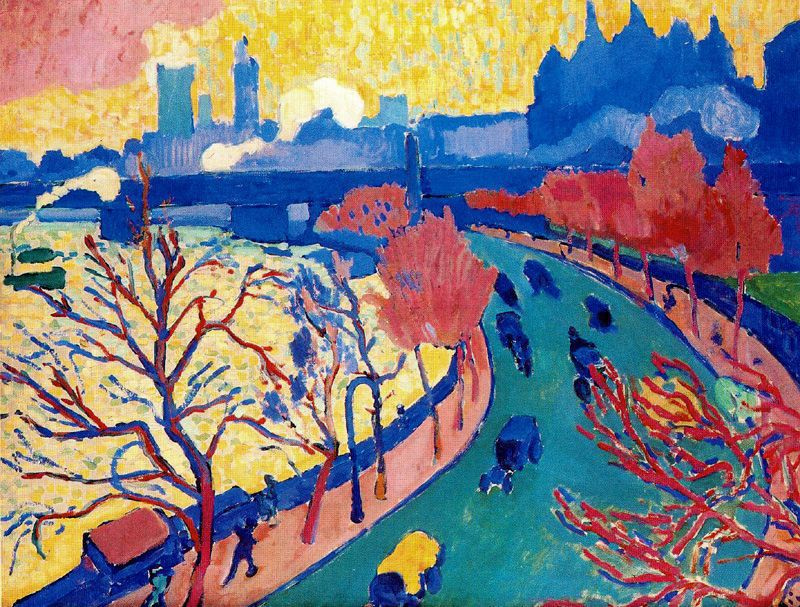log in
Enter site
Login to use Arthive functionality to the maximum
Charing Cross Bridge
Andre Derain • Painting, 1906, 81×100 cm
Description of the artwork «Charing Cross Bridge»
André Derain painted Charring Cross Bridge in London. The renowned Parisian gallery owner and art dealer Ambroise Vollard was impressed by Derain’s talent. He bought up all the paintings Derain had painted at that time and paid the artist a trip to London, commissioning him a series of British landscapes. Derain’s Fauvism included the elements of pointillism which was invented by Georges Seurat and Paul Signac — it was about the application of colour in separate dots. In Derain’s interpretation, those were not dots, but rather intermittently applied coloured spots and lines. The dominant role was given to colour, therefore the volume, depth and the depicted objects were subordinated to colour.
Derain depicted the north bank of the Thames and its turn towards Westminster. In the centre of the composition, there is a blue-green road heading towards a turn. It brings together the colour riot of the picture. The road is bordered by a pink sidewalk, which is limited by the blue walls. Narrowing of the road until it disappears completely creates perspective and a sense of distance, although the actual image remains two-dimensional. The Thames itself is bright yellow on the left, and the sky is yellow and pink behind the buildings in the background. The buildings are blue as the river on the right. At a closer look, in the buildings on the far bank, we can recognize Big Ben and the British Parliament. The intense colours in the foreground contrast with the pale, almost pastel background.
The artist applied the yellow colour using the pointillism technique. In general, he loved to work in this way precisely with sunny yellow and blue. For example, in another painting of the Charring Cross, the Thames water is yellow and blue again. And here is another example. On the shining Waterloo Bridge streams of sunlight literally pour from the sky, which is depicted in Derain's pointillist-fauvist technique.
When sending Derain to London, Ambroise Vollard hoped that the “wild” artist would repeat the success of Claude Monet in his manner. In 1904, an exhibition of Monet was held in Paris, with 37 of his London paintings on view. Monet painted both Charring Cross and the Waterloo Bridge. However, this story did not begin with Monet. The impressionist was undoubtedly influenced by Turner’s views of London, such as the legendary "Fire in the Houses of Parliament". Turner, in turn, despite all his originality, also did not appear from scratch, he was preceded by British landscapes by Canaletto. His "Westminster Abbey" and "The Bank Of The Thames" are overly clear and precise to speak of direct borrowings by the Impressionists or Derain, but weren’t it these sunbeams that laid the foundation for those who came to the Thames with their easels later?
Author: Aliona Esaulova
Derain depicted the north bank of the Thames and its turn towards Westminster. In the centre of the composition, there is a blue-green road heading towards a turn. It brings together the colour riot of the picture. The road is bordered by a pink sidewalk, which is limited by the blue walls. Narrowing of the road until it disappears completely creates perspective and a sense of distance, although the actual image remains two-dimensional. The Thames itself is bright yellow on the left, and the sky is yellow and pink behind the buildings in the background. The buildings are blue as the river on the right. At a closer look, in the buildings on the far bank, we can recognize Big Ben and the British Parliament. The intense colours in the foreground contrast with the pale, almost pastel background.
The artist applied the yellow colour using the pointillism technique. In general, he loved to work in this way precisely with sunny yellow and blue. For example, in another painting of the Charring Cross, the Thames water is yellow and blue again. And here is another example. On the shining Waterloo Bridge streams of sunlight literally pour from the sky, which is depicted in Derain's pointillist-fauvist technique.
When sending Derain to London, Ambroise Vollard hoped that the “wild” artist would repeat the success of Claude Monet in his manner. In 1904, an exhibition of Monet was held in Paris, with 37 of his London paintings on view. Monet painted both Charring Cross and the Waterloo Bridge. However, this story did not begin with Monet. The impressionist was undoubtedly influenced by Turner’s views of London, such as the legendary "Fire in the Houses of Parliament". Turner, in turn, despite all his originality, also did not appear from scratch, he was preceded by British landscapes by Canaletto. His "Westminster Abbey" and "The Bank Of The Thames" are overly clear and precise to speak of direct borrowings by the Impressionists or Derain, but weren’t it these sunbeams that laid the foundation for those who came to the Thames with their easels later?
Author: Aliona Esaulova


